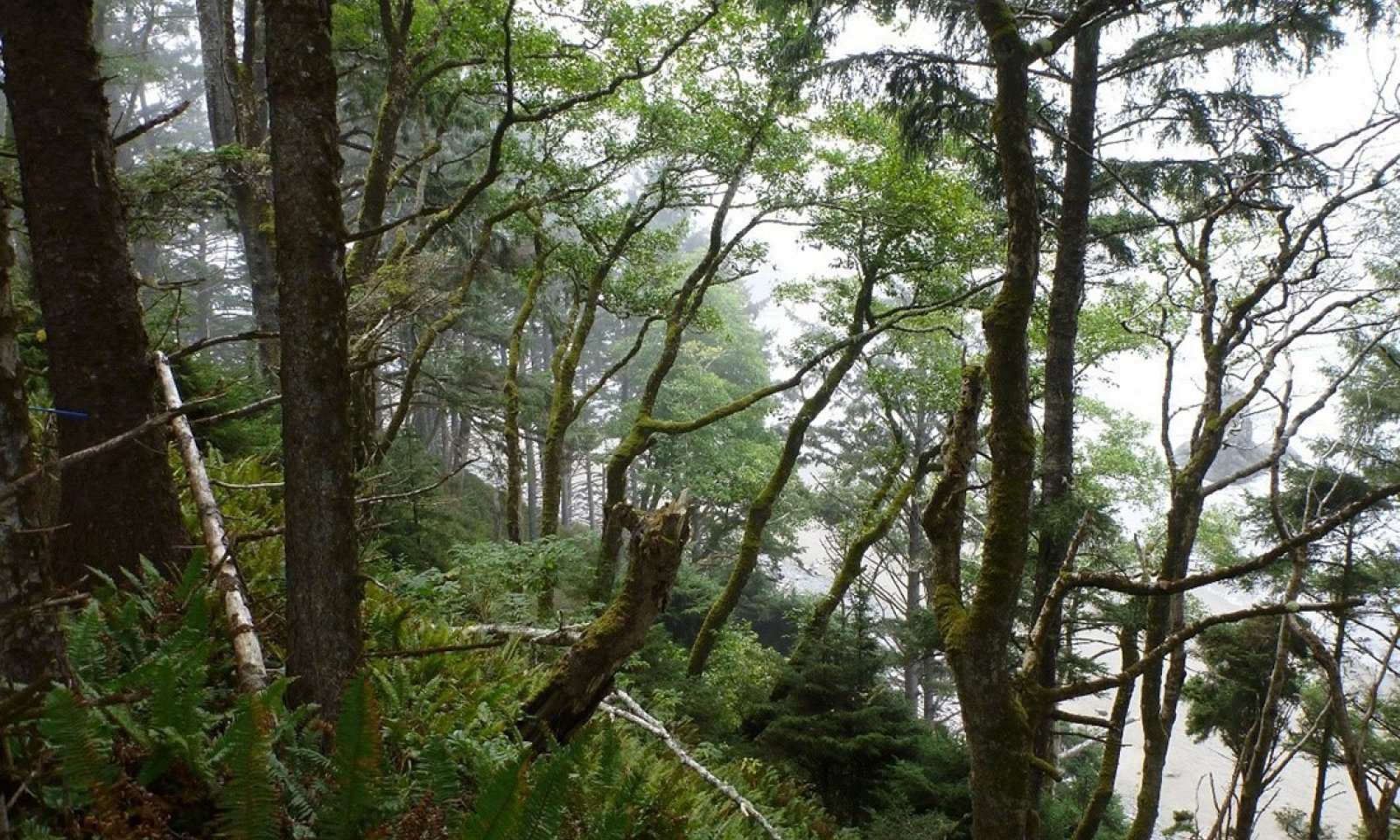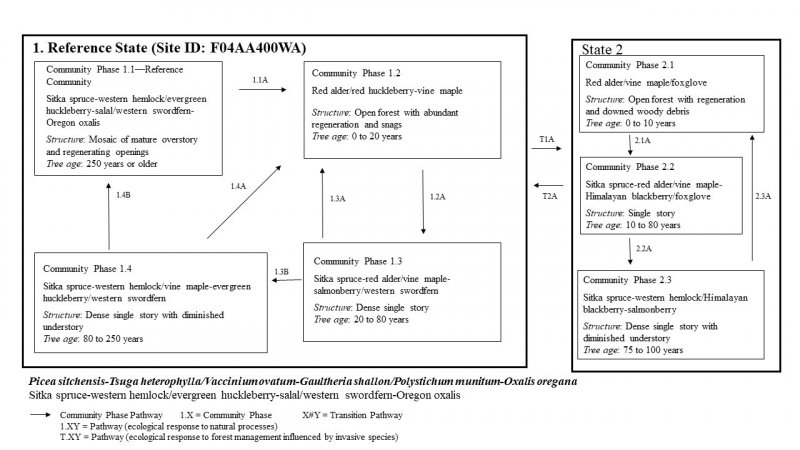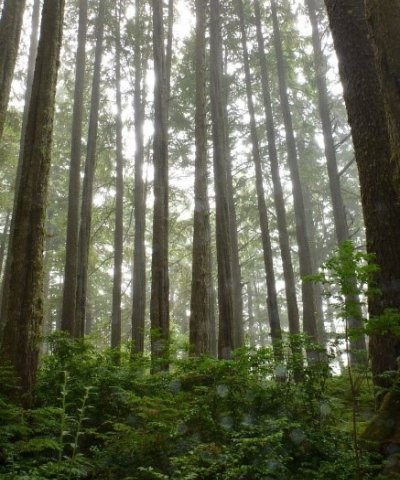Community 1.1
Sitka spruce-western hemlock/evergreen huckleberry-salal/western swordfern-Oregon oxalis
Structure: Mosaic of mature overstory and regenerating openings
Sitka spruce and western hemlock are the most common overstory species in the reference community. Sitka spruce is considered a seral tree species as compared to western hemlock, but several factors have contributed to its dominance in late successional forests (Taylor, 1990). Sitka spruce is highly tolerant of salt spray, and it grows well in mineral-rich soils that have low pH and high cation-exchange capacity (Peterson, 1997). Western hemlock is very shade tolerant; it is perhaps the most shade tolerant of any tree species in North America (Packee, 1990). It is presumed that western hemlock would outcompete Sitka spruce during extraordinary periods without disturbance. Douglas-fir and western redcedar likely are present, but minimal, if any, Douglas-fir regeneration occurs in closed canopy forests. The dense canopy created by multiple age groups of hemlock may block most of the sunlight from the forest floor, leading to sparse understory in some areas.
Gaps in the mid canopy and overstory allow sunlight to reach the ground, and a majority of the understory plants establish in these areas. The understory tends to be more continuous in areas that do not have a mid canopy. Common understory species include cascara, evergreen huckleberry, salal, red huckleberry, western swordfern, ladyfern, and Oregon oxalis.
Dominant plant species
-
Sitka spruce (Picea sitchensis), tree
-
western hemlock (Tsuga heterophylla), tree
-
Douglas-fir (Pseudotsuga menziesii), tree
-
western redcedar (Thuja plicata), tree
-
Cascara buckthorn (Frangula purshiana), tree
-
California huckleberry (Vaccinium ovatum), shrub
-
salal (Gaultheria shallon), shrub
-
red huckleberry (Vaccinium parvifolium), shrub
-
western swordfern (Polystichum munitum), other herbaceous
-
redwood-sorrel (Oxalis oregana), other herbaceous
-
common ladyfern (Athyrium filix-femina), other herbaceous
Community 1.2
Red alder/red huckleberry-vine maple
Structure: Open forest with abundant regeneration and snags
Community phase 1.2 is an early seral plant community that has been impacted by a stand-replacing disturbance such as a wildfire, a large-scale wind event, mass movement, or a major insect infestation. Nearly all trees are absent, but some fire-resistant trees may survive in the overstory. Standing, decaying snags are prevalent. The understory is dominantly early seral tree, shrub, and forb species such as red alder, red huckleberry, and vine maple. Some grasses will establish, but they will be replaced by shrubs over time. Depending on the severity of a disturbance, tree seedlings and saplings will begin to establish within 3 to 10 years.
Community 1.3
Sitka spruce-red alder/vine maple-salmonberry/western swordfern
Structure: Dense single story
Community phase 1.3 is an early seral forest in regeneration. Scattered remnant mature trees may be present. Species composition depends on the natural seed sources present and the intensity of disturbance. After a moderate or severe fire, shrubs likely will outcompete tree seedlings. Depending on the availability of sunlight, vine maple (Acer circinatum), red alder, red huckleberry, evergreen huckleberry, western swordfern, and salmonberry (Rubus spectabilis) may be abundant in the understory. Seed sources for tree species are surrounding, undisturbed forested areas and survivors of the disturbance. This results in a mixed stand that could include Sitka spruce, Douglas-fir (Pseudotsuga menziesii), western hemlock, and western redcedar (Thuja plicata). Sitka spruce in this community phase is vulnerable to outbreaks of white pine weevil.
Dominant plant species
-
Sitka spruce (Picea sitchensis), tree
-
red alder (Alnus rubra), tree
-
Douglas-fir (Pseudotsuga menziesii), tree
-
western hemlock (Tsuga heterophylla), tree
-
western redcedar (Thuja plicata), tree
-
vine maple (Acer circinatum), shrub
-
salmonberry (Rubus spectabilis), shrub
-
red huckleberry (Vaccinium parvifolium), shrub
-
California huckleberry (Vaccinium ovatum), shrub
-
western swordfern (Polystichum munitum), other herbaceous
Community 1.4
Sitka spruce-western hemlock/vine maple-evergreen huckleberry/western swordfern
Structure: Dense single story with diminished understory
Community phase 1.4 is a forest in the competitive exclusion stage. Scattered remnant mature trees may be present. Competition among individual trees for available water and nutrients is increasing. Sitka spruce and western hemlock are dominant in the overstory canopy; however, more shade-intolerant species such as Douglas-fir and western redcedar may make up a large portion of the overstory. The canopy closure is almost 100 percent, leading to diminished shrub and forb layers. Some understory species better adapted to at least partial shade begin to increase. Over time, the forest will begin to self-thin due to the elevated competition.
Pathway 1.1A
Community 1.1 to 1.2
This pathway represents a major stand-replacing disturbance such as a high-intensity fire, timber management, a large-scale wind event, a major insect infestation, or large mass movement that leads to the stand initiation phase of forest development.
Pathway 1.2A
Community 1.2 to 1.3
This pathway represents growth over time with no further significant disturbance.
Pathway 1.3A
Community 1.3 to 1.2
This pathway represents a major stand-replacing disturbance such as a high-intensity fire, timber management, a large-scale wind event, a major insect infestation, or large mass movement that leads to the stand initiation phase of forest development.
Pathway 1.3B
Community 1.3 to 1.4
This pathway represents growth over time with no further major disturbance.
Pathway 1.4B
Community 1.4 to 1.1
This pathway represents growth over time with no further major disturbance.
Pathway 1.4A
Community 1.4 to 1.2
This pathway represents a major stand-replacing disturbance such as a high-intensity fire, timber management, a large-scale wind event, a major insect infestation, or large mass movement that leads to the stand initiation phase of forest development.
Community 2.1
Red alder/vine maple/foxglove
Structure: Open forest with regeneration and downed woody debris
Community phase 2.1 represents a recently disturbed forest that is naturally regenerating. Large woody debris is commonly prolific following large-scale disturbances. This inhibits establishment of vegetation under natural conditions. Areas that are not replanted immediately (1 to 3 years) following timber harvesting or a large-scale disturbance may become vulnerable to an infestation of invasive species.
Typically, commercially managed forests will be replanted following disturbance. Species preference depends on site conditions and long-term economic decisions. Overall, species biodiversity is diminished in forests managed for short-rotation timber.
Natural reforestation depends on available seed sources following disturbance. Early seral species such as red alder and vine maple will regenerate quickly under abundant sunlight. Foxglove (Agalinis spp.) commonly is prolific following logging.
Community 2.2
Sitka spruce-red alder/vine maple-Himalayan blackberry/foxglove
Structure: Single story
Community Phase 2.2 represents an even-aged regenerating forest. Sitka spruce, western hemlock, shore pine, and Douglas-fir can regenerate quickly on nurse logs or in recently disturbed soil. A higher soil temperature favors seed germination of Sitka spruce, which commonly is the first coniferous tree species to re-establish following logging (Peterson, 1997). Shade-intolerant red alder remains a large component in the overstory until it reaches maturity (Fonda, 1974).
The plant community in areas that have been replanted commonly is dense and even-aged, and understory species are sparse in areas that have a high percentage of canopy cover. Vine maple and salmonberry are common understory species, but invasive species increase in prominence. Himalayan blackberry (Rubus armeniacus) has the potential to greatly impact the shrubby understory and outcompete native species. Foxglove will remain in pockets until eventually it is shaded out by the overstory shrubs or trees. Management techniques such as pre-commercial or commercial thinning and mitigation of invasive species will accelerate the maturation and improve the health of the forest.
Community 2.3
Sitka spruce-western hemlock/Himalayan blackberry-salmonberry
Structure: Dense single story with diminished understory
Community phase 2.3 represents a maturing forest that has increased plant diversity. Western hemlock will regenerate under a dense, shrubby canopy and begin to establish in the overstory canopy along with Sitka spruce. Invasive species will inhibit the overall health and structure of the forest, creating an ecosystem in which Sitka spruce is more susceptible to devastation by white pine weevil. The dense, shrubby understory is prone to wildfires. Commercial logging operations commonly take place during this phase as trees reach economical maturity in size and volume. It is presumed that without timber management during this community phase, an old-growth Sitka spruce and western hemlock stand will develop.
Pathway 2.1A
Community 2.1 to 2.2
This pathway represents growth over time with no further major disturbance or active forest management.
Pathway 2.2A
Community 2.2 to 2.3
This pathway represents growth over time with no further major disturbance or active forest management.
Pathway 2.3A
Community 2.3 to 2.1
This pathway represents a major stand-replacing disturbance such as a high-intensity fire, timber harvesting or other logging activities, a large-scale wind event, a major insect infestation, or large mass movement that leads to the stand initiation phase of forest development.
Transition T1A
State 1 to 2
This pathway represents a major disturbance that has removed most of the overstory. Large-scale disturbances have the potential to increase the vulnerability to infestations by invasive species when the seed source is nearby or introduced into the site. This type of disturbance will impact the natural feedbacks that maintained the reference state.
Restoration pathway T2A
State 2 to 1
This pathway represents intensive management to restore the historic plant community.




